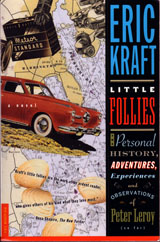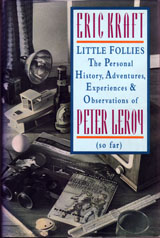 |
|
| It has often seemed to us that life, in several respects at any rate,
is much like a river.
Susanna and Elizabeth Christensen
Boating on the Bolotomy
|
 KNOW THAT many people agree with the Christensen sisters, but it has always
seemed to me that life, in several respects at any rate, is more like clam
chowder. My development of the exposition of this notion reached
its zenith one evening not long ago when I was chatting with Porky White,
the entrepreneur responsible for the Kap’n Klam chain of bivalve-shaped
fast-food huts, and Congo Red, the bartender at Corinne’s Fabulous Fruits
of the Sea.
KNOW THAT many people agree with the Christensen sisters, but it has always
seemed to me that life, in several respects at any rate, is more like clam
chowder. My development of the exposition of this notion reached
its zenith one evening not long ago when I was chatting with Porky White,
the entrepreneur responsible for the Kap’n Klam chain of bivalve-shaped
fast-food huts, and Congo Red, the bartender at Corinne’s Fabulous Fruits
of the Sea.
A surprising snowstorm had struck Babbington in
the morning, and Red was complaining about how long the trip from Hargrove
to Babbington had taken on the Hargrove-to-Babbington bus.
Suddenly, Porky poked me on the shoulder and asked,
“It’s a lot like life, isn’t it? A bus ride, that is.”
“Mmmmm?” I asked.
“Sure,” he said. “Just think about it.
You’re always on your way from one goddamned place to another, and you
have to pay for the trip, and nobody cares whether you get there or not,
and you feel miserable the whole time, and when you get there nobody’s
there to meet you, and like as not you step off the bus into some dog shit.”
Porky and Red collapsed into phlegmy, racking laughter.
I thought about what Porky had said.
“It seems to me,” I put forth, “that life is more
like clam chowder.”
They stopped laughing and regarded me with some
curiosity.
“Some people’s lives are the kind of chowder made
with cream,” I said, “which is quite acceptable, but others are the kind
made with tomatoes, which can be superb, especially with a little cayenne.
Each life is like an individual batch of chowder: some have too many potatoes,
and others have too much cayenne. Each has its high points—”
“The clams!” suggested Red.
“Of course,” I said. “And each has its low
points—”
“The potatoes!” offered Porky.
“Mmmmm—not necessarily,” said Red. “What about
the grains of sand that collect at the bottom of the bowl?”
“Oh, yeah, I forgot about that,” admitted Porky.
“Those may be the dark, gritty bits at the bottom of any life
that one would really rather forget,” I suggested. “Any dark, gritty
bits at the bottom of your life, Porky?”
“Well—”
Red and I enjoyed a little snickering at Porky’s
expense.
“Of course,” I said, pushing my empty glass toward
Red, “some lives have no sand at all, because they’re made with
canned
clams, but they’re a bland bunch. Now here comes the real secret
to a good chowder or a good life—a good broth. Why? Because
in any life, even the richest, one finds so very many moments that are
neither high nor low, those times when you scoop up a spoonful of broth
without any clams or potatoes or dark, gritty bits at all.”
“Amen,” said Porky, and I knew that he was convinced.
And yet, the Christensen sisters and all the people
who agree with them may be right. I will admit that part of my life,
my youth, has had at least a geographic resemblance to the course of the
Bolotomy River.
The Bolotomy flows from a spring-fed pond several
miles north of Babbington. This pond is at the heart of the Mayor
Harvey (“Heavy Harv”) McGee Memorial Park. At the center of the pond
is a tiny wooded island where, I believe, I was, on a January night, during
a skating party, just beyond the light and warmth of a bonfire, conceived.
In its early stretches, the Bolotomy is narrow and
shallow, barely a stream, but at one point, suddenly and surprisingly,
the river broadens and deepens, and for a short stretch it is an idyllic
swimming spot. When I was a boy, I often rode my bicycle to this
spot from my parents’ house. There the water was pellucid and cold,
the bottom was covered with small rounded stones, and the bank on one side
was flat and grassy. This spot was supposed to be a secret.
I was taught its location by a neighbor, an older boy who later broke my
foot for me by jumping on it. To reach the swimming spot, one rode
or walked along a well-used trail to a certain place where the sides of
the trail seemed to be closed by impenetrable bushes; then one stopped
as if to tie a shoe, looked over one’s shoulder and, if no one was in sight,
parted one pair of bushes carefully to open the way to another trail, a
narrow, damp one that led to the secret spot.
From time to time, the spot would be violated by
older boys and girls, who smoked and drank and frightened the rest of us,
and once a family arrived and spread out a blanket and ate a picnic lunch,
but most of the time children my age were the only swimmers.
Later, as a boy, and even more as a young man, I
spent a lot of time along the estuarial stretch of the Bolotomy, learning
things, talking, working, and wondering about the world outside Babbington.
And now, as I write this, some time after youth,
I’m on an island in Bolotomy Bay, surrounded by the river’s water, though
by the time it reaches this island the river water is no longer part of
the river. From where I work, I can look back across the bay and
a little way up the Bolotomy, back toward my beginnings.
I began planning “Life on the Bolotomy” while I
was sitting where I am sitting now, looking across the bay and up the river.
I remembered that I had wanted, as a boy, to travel the length of the river
and see what I could see. It would have been a perfect trip for Raskol
and me. I was taken at once with the idea of making the trip now,
of traveling up the river to find out where it began, how it became what
it was. If I were to make such a journey, I thought, I would need
a boat, a specialized boat, one that could navigate the narrow upper reaches.
I began sketching such a boat at once.
Peter Leroy
Small’s Island
December 17, 1982 |
|
 |


